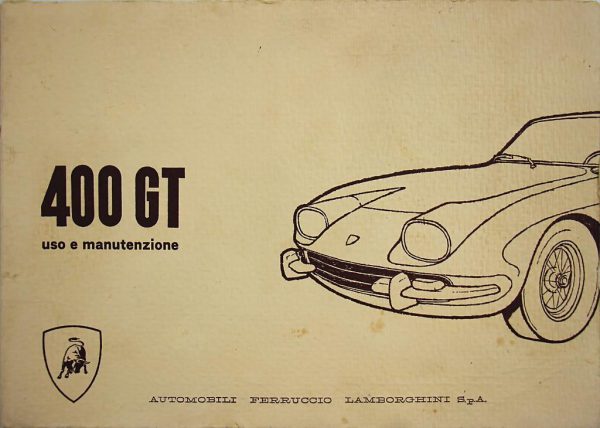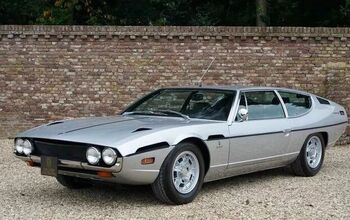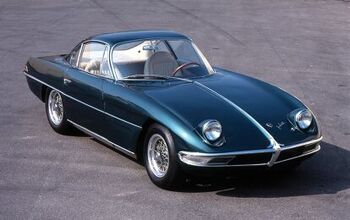Rare Rides Icons: Lamborghini's Front-Engine Grand Touring Coupes (Part IV)

The 350GT was Lamborghini’s first production car, and as we learned in our last entry, was a very rapid adaptation of the 350GTV prototype. And while the GTV was certainly more elegant looking than the GT, the former’s foibles included a hood line that was too low to fit the company’s V12, as well as a general lack of practicality.
Practicality was the word of the day in the 350GT’s development. The 2+1 grand touring coupe brought Ferruccio Lamborghini’s vision to life, as a competitor to the well-established finery from Ferrari. There were just 120 examples of the 350GT produced before its successor joined the ranks. The new car had a larger engine that made more power but looked very similar to its brother. Meet the 400GT.
Certainly not a clean-sheet design, the 400GT entered production in 1966. That was the final year the 350GT was offered, but as we’ll learn in a moment the actual 400GT was not quite ready. 1966 was an important year for Lamborghini as it launched its second model, a car that happened to establish the supercar class: The Miura.
The Miura was not a cheap project for Lamborghini, and the development dollars required for the daring mid-engine car meant the company’s grand touring coupe needed to continue without major visual changes. Would customers be able to discern between a 350 and 400 from the outside?
That was dependent upon how observant they were. A key differentiator between the two cars was the arrival of quad sealed beam headlamps, as the four lenses of the 400GT replaced the two ovoid headlamps on the 350GT. Apart from the headlamps, the rest of the front end was unchanged in the coupe’s transition into a new model. The bumper and grille carried over, as did the corner markers and wheels. Some examples received a little chrome bar that looped upward and tied the two corner segments of the bumper together (shown).
Along the side, onlookers would note the arrival of a chromed wing mirror. Sometimes only the driver received a mirror, and other times the passenger had one too. Said mirrors were also available with a black cap instead of a chromed one. Though the roof maintained the same basic shape as it had in the 350GT, the 400GT received a slightly taller roof line. That led to more glass area generally, a further nod to practicality. More on that in a moment.
At the rear, the casual observer would notice zero difference between a 350GT and a 400GT. Those with keen eyes might note the movement of the radio antenna: On the 350 it was on the right side of the trunk, near the brake lamp. 400GT saw its migration to the left side, atop the rear fender. Lamps, door mirror, roof, and antenna location were the only exterior differences between the first two Lamborghini touring coupes.
Given the 400’s body remained much the same as its predecessor, it was still built by Carrozzeria Touring and used their Superleggera build method. The 100.4-inch wheelbase carried over, as did the overall length of 176 inches. The width was identical between the two at 68 inches. However, the 400GT sat higher with its revised roof than the 350, and had an overall height of 49.5 inches over its predecessor’s 48″. As one would expect with an increase in engine size, the 400GT was also heavier: It weighed, 3,245 pounds, slightly more portly than the 350GT at 3,197 pounds.
Some of the additional weight was also due to the larger glass area of the raised roofline, and one key difference in the 400GT’s interior: Another seat! The odd 2+1 arrangement of the 350GT saw a single rear passenger seated in the middle of the car. In the 400GT the additional roof height meant there was room for 2+2 seating; two real human beings could fit into the back seat.
Elsewhere the interior remained the same in the transition from 350GT to 400GT, with one notable exception. It seemed early examples of the 350GT were not equipped with a radio, and it became an option later in the run. The 400GT had a dedicated space on the passenger side of the dash where a radio could be installed into a rectangular panel. On most examples of the 350GT, this panel was not present and the dash reflected a Touring logo in that area.
To create the 400GT’s power, Lamborghini took the Bizzarrini-designed 3.5-liter V12 and enlarged it to 3,929 ccs. Keen readers will notice the new car’s name should have been 390GT, but 400 sounded nicer. The 3.9 was the second of many enlargement procedures for the V12, and it retained the 3.5’s wet-sump lubrication. Recall the race specification of the GTV prototype promised 320 horsepower (but the engine was never installed), and when it was tuned for production-car specification that figure dropped to 280 horses.
The displacement growth made up for the original V12’s shortcomings, as the 3.9 produced 380 horsepower and 295 lb-ft of torque. The engine upgrade was a notable one in terms of power and was easy enough to complete on old 350GTs that some owners did an engine swap a couple of years into Lamborghini ownership. When the Miura debuted in 1966 it used the new 3.9-liter and kept it for its entire run. That particular engine configuration had good longevity at Lamborghini and lasted well into the Seventies.
Lamborghini put a transmission of its own design into the 400GT and got rid of the ZF box it had used in its first car. Of the five-speed persuasion, the new Lamborghini transmission featured a synchromesh on all gears and made the 400 easier to drive. But that wasn’t the only technology and livability change.
The 400 employed the Pirelli Cinturato tire. The Pirelli diagram above explains better than your author can, as someone who is not a scientist. The Pirelli design was the first-ever wrap-around radial tire and was first launched in 1952 when it was marketed as Cintura. Pirelli changed its name to Cinturato in 1963.
The Cinturato became standard equipment for high-end Italian cars for around three decades, all through the Seventies. A landmark tire, the original Cinturato pattern is still made today, and the Cinturato continues in modern form as the P7. The majority of modern passenger car tires are based on the Cinturato’s design.
The 400GT was ready for its debut at the 1966 Geneva Auto show, but was not put into production right away: There was a very limited run of a holdover model! While the upgraded 3.9-liter was ready to go, the taller-roof take on the 350GT’s body was not. When the new Lamborghini started production in 1966, the 400GT was later termed the “Interim.”
The Interim had new lamps, and a new engine, but the 350GT’s body and 2+1 interior. Just 23 examples of Interim were made before production switched over to the actual 400GT 2+2 in late 1966 or early 1967. Lamborghini created a very rare subset of the 400GT with the Interim, which was less usable than other examples (but more valuable later). Much more common, 224 examples of the 400GT 2+2 were made, in a short production run that lasted through 1968.
As soon as the 400GT concluded its tenure, Lamborghini was ready with another grand touring coupe. This one had all-new styling and looked much more modern than its predecessor. Subjectively, it might also be the most beautiful Lamborghini ever made. In our next entry, we’ll cover the only custom one-off take on the 400GT ever produced, and talk about the beautiful Islero.
[Images: Lamborghini, Pirelli, YouTube]

Interested in lots of cars and their various historical contexts. Started writing articles for TTAC in late 2016, when my first posts were QOTDs. From there I started a few new series like Rare Rides, Buy/Drive/Burn, Abandoned History, and most recently Rare Rides Icons. Operating from a home base in Cincinnati, Ohio, a relative auto journalist dead zone. Many of my articles are prompted by something I'll see on social media that sparks my interest and causes me to research. Finding articles and information from the early days of the internet and beyond that covers the little details lost to time: trim packages, color and wheel choices, interior fabrics. Beyond those, I'm fascinated by automotive industry experiments, both failures and successes. Lately I've taken an interest in AI, and generating "what if" type images for car models long dead. Reincarnating a modern Toyota Paseo, Lincoln Mark IX, or Isuzu Trooper through a text prompt is fun. Fun to post them on Twitter too, and watch people overreact. To that end, the social media I use most is Twitter, @CoreyLewis86. I also contribute pieces for Forbes Wheels and Forbes Home.
More by Corey Lewis
Latest Car Reviews
Read moreLatest Product Reviews
Read moreRecent Comments
- Orange260z I'm facing the "tire aging out" issue as well - the Conti ECS on my 911 have 2017 date codes but have lots (likely >70%) tread remaining. The tires have spent quite little time in the sun, as the car has become a garage queen and has likely had ~10K kms put on in the last 5 years. I did notice that they were getting harder last year, as the car pushes more in corners and the back end breaks loose under heavy acceleration. I'll have to do a careful inspection for cracks when I get the car out for the summer in the coming weeks.
- VoGhost Interesting comments. Back in reality, AV is already here, and the experience to date has been that AV is far safer than most drivers. But I guess your "news" didn't tell you that, for some reason.
- Doc423 Come try to take it, Pal. Environmental Whacko.
- 28-Cars-Later Mazda despite attractive styling has resale issues - 'Yota is always the answer.
- 28-Cars-Later Try again.











































Comments
Join the conversation
Needs flip up headlights
I've always liked the 350GT and 400GT more than any of Lamborghini's mid engine models except for the Miura. Both the asking prices and maintenance costs are more than I can afford.